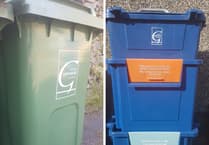Plans to extract 800,000 tonnes more sand and gravel from a Gwynedd quarry have been given the green light.
Gwynedd Council approved plans to extend Cae Efa Lwyd sand and gravel pit near Penygroes – but the approval came with 43 conditions attached.
Conditions included detailed archaeological reports to limits on the hours of working.
Other conditions included traffic recording, noise limitations, air quality monitoring, mitigation measures for badgers, breeding birds and reptiles, water disposal and identifying the site by its Welsh name.
The committee heard there was a deficit in the county’s landbank and a 2.6m tonne need for sand and gravel.
The extension would see an 800,000 tonne increase in the extraction amounts, but the plans did not afford rights for processing.
The quarry would release sand and gravel in addition to the 298,000 tonnes remaining, and would give 1.1 million tonnes in total.
The extraction would be limited to 125,000 tonnes a year and would take approximately 10 years to complete.
The plans would extend the site northwards by 4.1 hectares, west of Penygroes.
A vehicular access completed in March 2019, under a separate permission, would continue.
A geophysical survey and trial trenching had been undertaken and archaeological mitigation had included identifying and recording features and remains and avoiding a prehistoric circular enclosure.
Gwynedd Archaeological Planning Service (GAPS) had reviewed submitted archaeological information.
In its response it stated that an assertion that “extensive archaeology” was unlikely to be present was “not supported by the evidence submitted”.
“There was presence of archaeological remains and potential for a prehistoric enclosure and small settlement located partially within the extraction area,” it stated.
Two key points raised in their response said that a Heritage Impact Assessment “did not meet professional standards for an archaeological desk-based assessment”.
Post-excavation work arising from the trial trenching had also “not been undertaken and needed to be completed to understand what had been found”.
But GAPS did not object to the application subject to conditions being imposed.
These included submission of a written scheme of investigation for archaeological work prior to the extension.
Mineral extraction at Cae Efa Llwyd Fawr – where work had started again in 2017, 65 years after planning permission was first granted, had previously prompted objections from locals.
Cllr Gruff Williams said of that application “locals had felt they were hitting their head against the wall by not being listened to”.
“They did not feel any point in objecting this time,” he said.
“The old agricultural lands that are listed in historical books are going to be ripped up so we can pour concrete here and there across Wales. I can’t agree with this.”
Planning officer Gareth Jones said: “This land is designated as land where extraction of sand and gravel extraction is preferred.
“There is a need for this material within the county, there have been no objections by any of the statutory consultees.
“The application has been given consideration in accordance with relevant planning policy, in line with environmental issues, and relating to development.”
It was agreed to delegate powers to the Head of the Environment Department to approve the application, subject to 41 conditions.
Cllr Huw Wyn Jones proposed approval, seconded by Cllr Anne Lloyd Jones – providing “all 43” conditions were imposed.
The vote was passed with ten in favour and two against.



.jpeg?width=209&height=140&crop=209:145,smart&quality=75)

Comments
This article has no comments yet. Be the first to leave a comment.